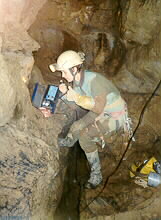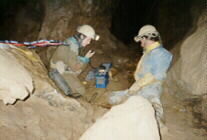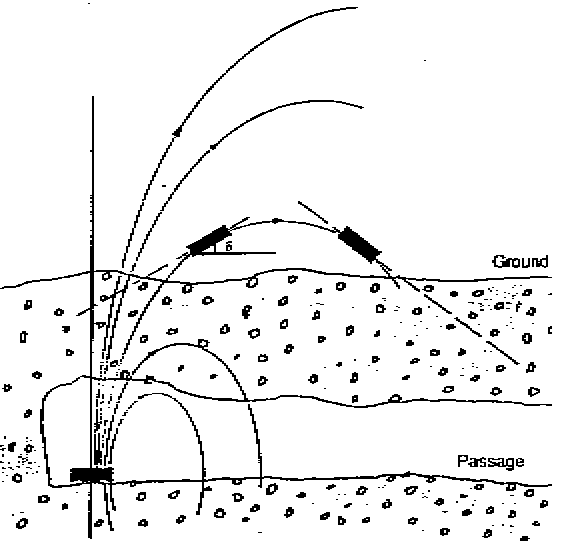|
              
THE TECHNICAL PAGES
The cave radio
Abstract: description of the first wireless cavephone ever build in Belgium,
according to a British Design by John Hey. It gives the possibility to establish
voice-communications between the surface and a team in the cave, up to a
depth of well 100 m (actually, depths of 500 m are in within reach!!).
Author: Herman Jorens.
INTRODUCTION
Everyone who has ever tried to establish a connection between cavers
underground and a surface-team, using Walkie-Talkies, knows that this does
not work! Even communicating IN the cave itself with Walkie-Talkies is often
not possible (except in big rooms).
Special cave-radios have been developed, that can send their signals
through solid rock. In Great-Britain, they are being used quite often, but
on the continent their use is still exceptional. In Belgium, as far as I
know, they have never been build nor used before. In France some experiments
have been conducted.
SOME HISTORY
Radio-communication through solid or liquid substances is not that simple!
The higher the frequency, the better the surrounding matter will absorb
the radio waves. This is why Walkie-Talkies won't work, unless the transmitter
and receiver can "see" each other.
The lower the frequency, the better the waves penetrate in the solid
or liquid matter. Submarines are using since many years low frequencies
to establish communications with surface-stations, by trailing long antenna's
behind them. This illustrates one of the main disadvantages of low frequency-radios:
the antennas get real big. That's why cave-radios use antennas that are
made of cable, wound in a small loop.
In the 70ties, some British cavers started experimenting with VLF (Very
Low Frequency) transmitters to try to establish radio-communications between
the surface and a cave. After some years of trying and inventing the right
antennas, they succeeded in their plans. These first cave-radios were pretty
big and used a lot of (battery)power, so cavers were dragging around considerable
weights! But things soon got smaller and lighter. Two popular designs were
the Ogophone and the Molephone, capable of reaching
depths around 150-180 m.
The Molephone was commercialized and can still be bought. The design
is secret. The design of the Ogophone however was published, and amateurs
can still rebuild this type of radio. The antenna is a loop with a diameter
of 1 metre, made out of 64 turns of computer- flat cable. The radio is build
into an ammunition box, since British cavers like to drag these things around.
The battery is put in a separate box.
CURRENT SITUATION
Currently, cave radio's are commonly used in Great-Britain, especially
by the Cave Rescue Organisation. No more dragging telephone wires around:
the Rescue team leaves with two ammo-boxes, plugs in the microphone and
antenna, and they have a vocal communication with the surface-team. If necessary,
the receiver (surface) is connected to a normal telephone or G.S.M. so the
underground Rescue-team can speak to a doctor or hospital!
In Great-Britain there is a user group, called the CREG (Cave Radio &
Electronics Group). They are a division of the BCRA (British Cave Research
AsSociétéation). These guys like to experiment with cave radios. In fact, the
predecessor of the cave radio, a loop-wound antenna that gave a 3kHz "beep-beep"
signal, was born here. It was used to for radio-positioning (positioning
an underground point at the surface). One of our members, Jan Geboers, build
one and we use it quite often. You'll find a description of it a bit further
in these pages!
BUILDING A CAVE RADIO
Since a couple of months, I had the idea of trying to build a cave radio.
The Ogophone is pretty complicated to construct (since one has to wind several
coils, and that is not easy at all). In the winter of '96 I discovered the
"CREG" and saw in their publications the design of a new cave radio. It
was small, compact and made with modern components. Not one single coil
in it! I contacted the maker of it, John Hey, a caver, radio-amateur (G3TDZ),
engineer in electronics and, thank God, a very helpful guy.
Constructing these radios was not so simple. Although I had copies and
descriptions of the circuit-boards, a lot of problems had to be solved.
Some of my friends did not believe in my project, but this stimulated me
even more. I worked every evening, sometimes 'till 2 o'clock in the morning,
to get the transmitters/receivers working. John and I faxed each other 2
times a week.
On June, 2 1996 the first underground test was conducted. Patrick (another
Avalon-member) and I made voice-contact through 60 m of solid rock! We had
a very clear communication. As far as I know, this was the first time ever
(in Belgium) that wireless voice-contact was established between a cave
and the surface.
 After some modifications in the receivers a second test was held. This
time we chose one of the deepest caves in Belgium, Trou Weron. We established
a voice-contact between the surface and the final sump of the cave, 106
m deep! (see picture). The cave
was unfortunately situated under some high-tension powerlines and these
interfered with my radios.
So we held a third and final test in the Sainte-Anne cave. Crystal-clear
communications between the cave and the surface (95 m higher) was made. After some modifications in the receivers a second test was held. This
time we chose one of the deepest caves in Belgium, Trou Weron. We established
a voice-contact between the surface and the final sump of the cave, 106
m deep! (see picture). The cave
was unfortunately situated under some high-tension powerlines and these
interfered with my radios.
So we held a third and final test in the Sainte-Anne cave. Crystal-clear
communications between the cave and the surface (95 m higher) was made.
In October '96, our club stayed for a week in Yorkshire and participated
at a "field-meet" of the CREG. We experimented with different kinds of radios
in an abandoned cupper-mine near Richmond. My radio reached a (horizontal)
distance of 140 m through solid rock.
WHAT DOES THIS RADIO LOOK LIKE?
The transmitter/receiver has more or less the dimensions of a car-radio.
At the front there are some knobs and switches, and the connectors for the
microphone, antenna and battery. All this fits in an ammo-box. The battery
also fits in this box, so do the microphone and some cleaning-attributes.
Everything is surrounded by shock-proof foam. The ammo-box is waterproof.
There are two identical sets.
The antenna is a hexagonal loop, made out of 22 turns of isolated wire
(0.75 mm2). It can be mounted on 3 wooden laths. Everything can be plied
together and be transported in a PVC sewer pipe, 110 mm diameter.
The transmitter functions on 87KHz, in SSB modulation and has an output
of 10Watts. In fact we should better call it an "induction transmitter",
because it emits induction waves.
HOW TO USE IT
The transmitter/receiver has a build-in "beacon". When this is activated,
it will emit a powerful "morse-like" signal that enables the surface team
to track the transmitter over long distances (several hundreds of metres).
One transmitter/receiver set is put into the cave with the antenna flat
on te ground. The beacon is switched on. The surface team will quickly pick
up the beacon and now has to locate the point that is straight above the
transmitter. At that location, the distance is at it shortest and voice-communication
will be at it's best. The surface team proceeds as follows: they keep the
antenna vertically and rotate it slowly around the vertical
axis. When the signal (beacon) dies out, the antenna will be in a plane
that points either to the underground transmitter, either in the opposite
(180 degrees) direction. By repeating this test at 2-3 different places,
each 20-30 metres apart, they can quickly tell where the transmitter is
located. They'll hurry to this spot and just start ...talking in the microphone!
If the depth isn't too deep, let's say 2/3 of the maximum reach (140 m),
they'll have a crystal clear voice communication, sometimes better than
on a GSM handheld telephone!
PRACTICAL USE
Here a list of things that you can use a cave-radio for:
- Cave rescues: this is probably the most common use of cave-radios.
It is indeed a lot easier and quicker to carry a cave-radio through the
cave, than it is to roll out telephone wires. It is also a lot more secure:
telephone wires get tangled or cut easily, especially during a rescue. With
the cave-radio, the underground rescuers keep in contact with the surface-team,
or even remote sites: a doctor, hospital, or relative of the victim, if
the surface team has a GSM hand phone available (just hold it in front of
the loudspeaker of the cave-radio!)
- Exploring flood-prone caves: in such circumstances, it is vital
that the underground team is
 informed
about changing weather situations. This is especially useful in case of
explorations, where underground camps are used, and where cavers are staying
for several days in the cave without having an idea about the weather outside! informed
about changing weather situations. This is especially useful in case of
explorations, where underground camps are used, and where cavers are staying
for several days in the cave without having an idea about the weather outside!
- Cave-diving: the cave-radios also work between two parts of
a cave or even different caves. One set can be taken along by divers, behind
a sump. It will allow the diver to stay in touch with the team before the
sump. Very re-assuring indeed! It will also allow him to report any problem
that arises.
- Announcing your return: a team that returns from the bottom
of the cave, can, as soon as they are at a depth of -140 m, announce their
return to the surface-team. Very nice indeed, when you like a fresh beer
when you get at the entrance of the cave!
- Making radio-locations or estimating depths: Using the cave-radio,
one can make radio-locations or estimate depths (using the "beacon") in
the same way as with the "Induction Loop" (see article nr 4 on these pages!)
. One big advantage is that a vocal contact is also possible, thus permitting
to do several radio-positionings in one day. Without voice-contact, you
would have to agree on a very strict time-schedule (which often can't be
kept).
Estimating the depth is done by measuring the angle of the waves.
First the "ground zero" (= the spot just above the underground transmitter)
is located, by holding the antenna vertically and doing a small triangulation.
Then one will step away from this point for a short distance (depending
on the depth: 20-50 m should do). One keeps the antenna horizontally
and slowly tilts it downwards, pointing at "ground zero". The "beacon" will
fade out at a certain position. Keep the antenna firmly in this position,
and measure the angle between the frame of the antenna and
the earth. An electronic inclinometer is just what you need for this job!
Using this formula you can calculate the depth:

Depth = 2L / V((9tanA?) + 8-3tanA))
where:
V=square root
L= distance between ground zero and the centre of the antenna
A= angle between antenna and earth
A LOT EASIER is this method: step away from ground zero, holding the
antenna horizontally and tilted 45 degrees downwards, until the "beacon"
fades out. The depth of the transmitter is now 1.77 times the distance between
you and ground zero! In the field, having no calculator available, you can
easily make a good estimate by multiplying the distance by 2, and subtracting
10% (thanks, Stuart France, for this tip!). Example:
exact result: 22 m x 1,77 = 38,9 m
or appr.: 22 m x 2 = 44 m -10% = 39,6 m.
CONCLUSION
Why did I start this project in the first place? Well, because it interests
me a lot, and because it was about time that a cave-radio was being build
in Belgium! I also hope that this article could stimulate people to start
experimenting with caving electronics.
In England, they now experiment with "Cave Pagers", small beepers that
can be carried inside the oversuit and that can be used to warn an underground
team (in case of changing weather, for instance). I'm confident that in
5 years, cave-radios or pagers will be commonly used in the caving world.
. They'll always get smaller and reach bigger depths. One day, we will talk
at -1000 m with the surface team. Actually, depths of +/- 500 m are already
within reach!
If you would like any additional information, feel free to contact me:
Jorens Herman, Randerode 68, 2940 Stabroek, Belgium
tel: +32 3 568.16.45 fax: +32 3 561.40.56 (f.a.o. Jorens H.)
If you'd like to learn more about cave radios; in particular the "Nicola
System" developped by Graham Naylor, then surf to:
http://naylorgr.perso.cegetel.net/cave_radio/
LATE BREAKING NEWS (April '98)
Actually, we are experimenting with a totally different type of antenna.
Instead of a loop, two wires (ordinary 0,75 mm2 electrical wire)) are used
(both underground and at the surface) that are tended in opposite directions.
At their ends they are fixed to a small steel pin that is driven in the
soil of the cave and surface. The longer the wires, the deeper one can communicate!
These antenna's are a LOT lighter and smaller than the bulky loop-antennas.
We recently tested this system in a French cave and were able to establish
an incredibly crystal-clear communication (clearer than a GSM-handphone!)
at a depth of 350 metres!
We used wires that were only 17 metres long. The conditions were ideal,
since the cave was large and had a muddy soil. What a great feeling to hear
Herman say that the sun was shining, and that he was lying in the soft grass
listening to the birds... while we were still a long way from home!
French cavers also have build John Hey's cave-radio and they recently
reached depth's of well over 600 m in the Dent des Crolles, using 80 metre-wires.
Its is clear that these new antennas give enormous possibilities for
the exploration of deep-cave-systems. Establishing vocal communication with
a team or underground camp, 500 m deep, is now only a matter of minutes.
Cavers will be held alert of changing weather-conditions, will be able to
report any problems or progress, or will just simply be comforted by the
voice of their teammates at the surface...
|
